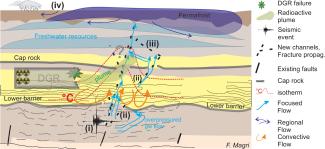
DFG-RFBR project "Impacts of glaciation, permafrost and tectonic conditions on far-field radionuclide evolution following a potential repository failure case"
Among the considered solutions to date, the most secure, technically feasible and internationally accepted solution for the safe management of Radioactive Waste (RW) is burial in deep host rock units, also referred to as disposal in a deep geological repository (DGR). For this purpose, it is mandatory to select a site in a hydrogeological setting which provides sufficiently safe natural conditions for waste isolation from groundwater flow over long time periods (up to 1 Ma).
However, over such a long time period, external factors (e.g. climate change) and intrinsic basin features (e.g. tectonics), here referred to as changing conditions, will impact the hydrological (H), thermal (T), mechanical (M) and chemical (C) state of the entire system. Therefore, it is crucial to better understand the impacts of changing conditions on far-field radionuclide mobilization and behavior in order to select the most suitable DGR for RW disposal.
Multiphysics simulators offer powerful tools that couple groundwater flow (H), transport of heat (T), as well as geochemical reactions (C) in a deforming solid framework (M). These coupled THM-C numerical models can provide evaluations for performance and safety assessment of a DGR at different scales. However, a limited number of studies so far addressed the far-field evolution of radionuclides under the changing conditions listed above.
The newly funded German Science Foundation (DFG) and the Russian Foundation for Basic Research (RFBR) project “INFRA” (NA1528/2-1 and MA4450/5-1; 2020-2022) aims to investigate the impacts of (i) glaciation, (ii) permafrost and (iii) tectonic events on the coupled phenomena that control large-scale groundwater flow near hypothetical waste repositories. For this purpose, the open-source simulator OpenGeoSys [1,2] will be applied using available data from selected areas of the Yeniseisky Site in Russia [3].
Though the context of this study is related to RW issues, the outcomes of INFRA will be of interest for any field of geosciences that deals with large-scale simulations of coupled processes under transient boundary conditions.
[1] Kolditz, O., Bauer, S., Bilke, L., Böttcher, N., Delfs, J. O., Fischer, T., … Zehner, B. (2012). OpenGeoSys: an open-source initiative for numerical simulation of thermo-hydro-mechanical/chemical (THM/C) processes in porous media. Environmental Earth Sciences, 67(2), 589–599. https://doi.org/10.1007/s12665-012-1546-x
[2] Bilke, L., Flemisch, B., Kalbacher, T., Kolditz, O., Helmig, R., & Nagel, T. (2019). Development of Open-Source Porous Media Simulators: Principles and Experiences. Transport in Porous Media, 130(1), 337–361. https://doi.org/10.1007/s11242-019-01310-1.
[3] Laverov, N., Yudintsev, S., Kochkin, B., Malkovsky V. (2016). The Russian Strategy of using Crystalline Rock as a Repository for Nuclear Waste. Elements, 12(4), 253–256. https://doi: 10.2113/gselements.12.4.253
(i) Cap-rock failure due to seismic events (but also slower tectonic processes)
(ii) focused flow escapes from the aquifer (driving forces, flow field?)
(iii) flow-induced fractures propagate generating a heterogeneous porosity-permeability field
(iv) Changing climate/permafrost impacts
From: Aus: Magri, Nagel, Liebscher, Malkovsky. EGU2020-17712.
PIs
PD Dr. Fabien Magri, Freie Universität Berlin and Federal Office for the Safety of Nuclear Waste Management (BASE)
Prof. Dr. Thomas Nagel, TU Bergakademie Freiberg
Prof. Dr. Victor Malkovsky, Institute of Geology of Ore Deposits, Petrography, Mineralogy, and Geochemistry, Russian Academy of Sciences